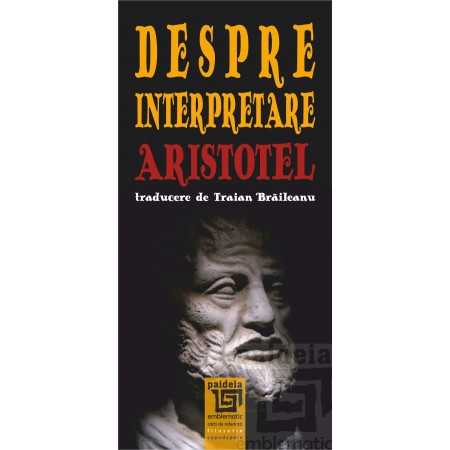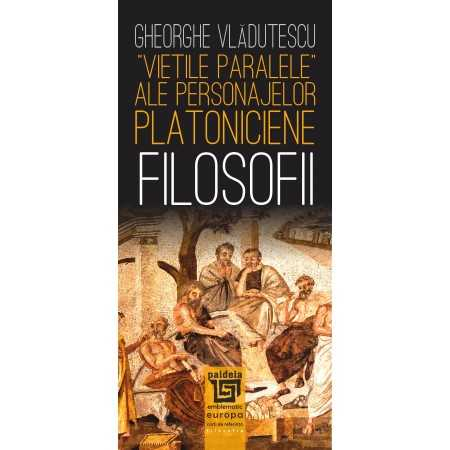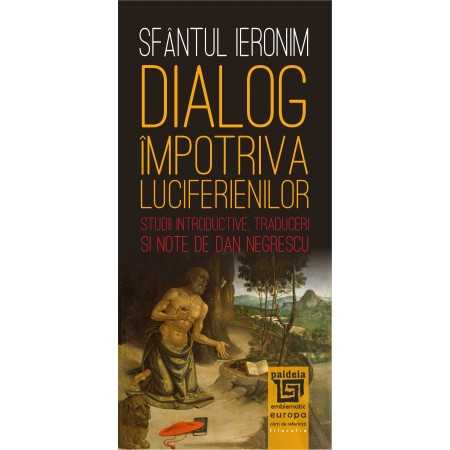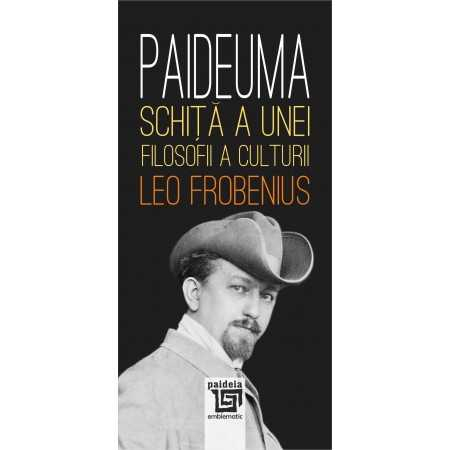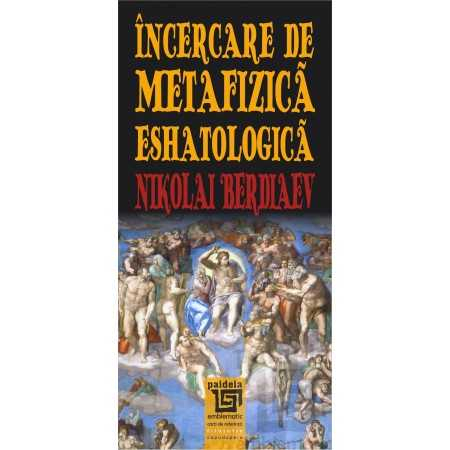6359.png) Spiritual utterances. Notes on Dumitru Staniloae, Lucian Blaga and Mircea Eliade, in the vision of the mystical tradition of the Christian East
Spiritual utterances. Notes on Dumitru Staniloae, Lucian Blaga and Mircea Eliade, in the vision of the mystical tradition of the Christian East
Publisher: Editura Universitara
Author: Adrian Tiglea
ISBN: 978-606-28-1272-0
DOI: https://doi.org/10.5682/9786062812720
Publisher year: 2021
Edition: I
Pages: 318
- Description
- Download (1)
- Authors
- Content
- More details
- Where to find it
- Reviews (0)
conf. univ. Dr. Corina Matei, Christian journalist
-
Spiritual utterances. Notes on Dumitru Staniloae, Lucian Blaga and Mircea Eliade, in the vision of the mystical tradition of the Christian East
Download
He is the author of the works Culture and mentalities in the era of the Great Union: a perspective on Romanian modernity, Leon Kalustian: knight of freedom, Memorator of Philosophy for high school, Memorator of Sociology for high school.
Journey into the heart of metaphysical experience, in its religious hypostasis / 15
Sacred interferences: The impersonal God of philosophers. The transcendent and personal God of Eastern theologians / 22
The cunning of the unconscious and the critique of the Christian religion. Nietzsche's violent anti-Christian / 59
The universe of the personal and collective unconscious / 78
Conscious, unconscious and the archetypes of the collective unconscious / 91
From German philosophical romanticism to the mysterious faces of the unconscious in the work of Lucian Blaga / 107
Apophatism and theophanies of the sacred: The Great Anonymous of Lucian Blaga. The Revealed God of the Old Testament / 123
The singularities of the human being, in his relationship with the Absolute / 149
Prefigurations of the Savior Jesus Christ in the pages of the Old Testament / 202
Jesus Christ, the Word of love and light. The work of the prayer of the heart / 224
Meanings of the saving sacrifice of the Lord Jesus Christ / 244
Romanian spiritual physiognomies / 253
From the archaic man to the modern man. Camouflage of the sacred in the profane / 272
Final roasts / 297
Bibliography / 312
Adrian Tiglea bases his work on the apophatic doctrines of the Holy Fathers, proving a thorough deepening of the content of the Philocalia and, equally, of the Bible. The incomprehensible character of God is emphasized throughout the Old Testament, as well as in the writings of some reference names of Eastern Christianity, to which the author refers. As Adrian Tiglea correctly reiterates throughout his book, in His Being, God is incomprehensible to the senses and to reason. This spiritual truth must not, however, discourage the Christian on the spiritual path of approaching God. The spiritual ascent to God, which presupposes the renunciation of man's passions and the cultivation of Christian virtues, occasiones the communion of divine grace, man himself deifying himself by grace, in the sense of spiritual imitation of the divine archetype. The author proves this spiritual truth by analyzing the work of some reference authors of Eastern Christianity, such as: Dionysius the pseudo-Areopagite, Saint John of Damascus, Saint Maximus the Confessor, Saint Isaac the Syrian, Simeon the New Theologian, the Pious Nichita Stithatul, Saint Hesychius Sinai Basil the Great, John Chrysostom, St. Gregory of Nyssa, Gregory of Nazianzus and St. John the Scarecrow. All these authors identify different stages of the spiritual ascent to God and share with us their own spiritual pedagogy of approach to the threefold Saint.
After an interlude dedicated to some thinkers who attacked Christianity, among which Friedrich Nietzsche is the theoretical landmark subjected to a detailed analysis, Adrian Tiglea conceptually crosses the realm of personal and collective unconscious. He stops short of Sigmund Freud and Carl Gustav Jung, articulating a reference introduction to the unconscious present in the work of Lucian Blaga, as a defining concept.
Despite the differences between the three authors, the idea that the unconscious plays a decisive role in the creations of culture proper to the human spirit is striking.
While, for Sigmund Freud, the unconscious is a simple storehouse of the psychic elements repressed from the person's consciousness, a pathogenic source in psychic life, for Carl Gustav Jung, it is not limited to the personal history of the individual and is not entirely negative as an influence on consciousness can even be the substratum of inspiration and creation in culture. Today, it is a widely recognized cultural gain to postulate the existence, in the human psyche of anytime and anywhere, of the collective unconscious; it is seen as an environment other than the conscious, as a phylogenetic heritage and as the seat of the wisdom of the species, the wisdom of the great human experiences "precipitated" mnemonically into archetypes. Also, the Jungian theory of archetypes has been taken over or re-signified by many thinkers and creators in the field of art, philosophy, cultural anthropology, history of ideas, philosophy of religion, etc. The archetype has been described as a form of the human psyche of universal spread, as a universal human way of experience and behavior, expressed through recurring symbols and motifs, present in all mythologies.
Adrian Tiglea points well documented the theoretical separation of Carl Gustav Jung from his master, Sigmund Freud: the rejection of the exclusivism of Freudian sexual theory in explaining the nature and functioning of the personal unconscious; assuming an energetic conception, but also axiological on it; the extension of the research of the unconscious beyond the personal one and the development of one's own theory regarding the collective one. The author manages to highlight the highest spiritual values of the Jungian vision, which reveals even more its closeness to that of Mircea Eliade, especially regarding the positivization of the unconscious and symbolic, mythical, archetypal thinking: collectively it means the extension of man beyond himself, the "death" of his personal being, the rebirth in a new spiritual horizon "(p. 76).
Mircea Eliade correlates the thesis of the existence and manifestation in the culture of humanity of archetypes with that of their participation in cosmic principles, in an ultimate, metaphysical reality. The historian of religions considers the archetype as "a reality beyond the individual consciousness and beyond the collective unconscious." The archetype is, in his view, transcendent, not immanent; a structure not of the abysmal depths proper to human psyche, but of reality itself (p. 88).
The ideational correspondents from the works of Jung and Eliade are known, as a result of the assiduous communication between them during the meetings in Ascona, in Switzerland, under the aegis of Eranos. Perhaps this explains Mircea Eliade's note in his Memoirs, according to which the great Swiss psychoanalyst was concerned, towards the end of his life, to read only patristic theology, declaring himself disappointed by the spiritual "blindness" of contemporary psychologists and psychoanalysts.
Another landmark in exploring the influence of the unconscious on human consciousness and creativity is Lucian Blaga. Like Carl Gustav Jung, the philosopher endows the unconscious, especially in its collective aspect, with creative and mythological predispositions. Thus, the emphasis in Blagian philosophy falls on the unconscious spirit and its stylistic coordinates, on the modeling functions in culture and creation, as they are found in various peoples, from archaic to today. The Romanian philosopher notes: "Our preoccupations are not related to the problem of the psychology of peoples, but are directed towards a possible doctrine of the" spirit ", which we endow with heterogeneous sets of categorical functions. Such a doctrine, once fully clarified in its intentions, would allow it to be called "abysmal noology" (noos - spirit, abysmal - unconscious).
The author of the book concludes, following the analysis of the Blagian conception regarding the stylistic matrix: we carry in our personality, until today, a series of archaic soul or spiritual components, often in a masked form. The stylistic matrix is described as a bunch of categories that have their "nest" in the unconscious and that imprint all human creations: works of art, metaphysical concepts, scientific doctrines and visions, ethical and social concepts, etc. Finally, the stylistic matrix imprints life and thought itself, insofar as it is shaped by the unconscious spirit.
This aspect determines the Romanian psychoanalyst Vasile Dem. Zamfirescu to draw attention to the need to assume, in philosophy, this "impurity" of our spirit, represented by the manifestation in it of the unconscious soul. Also, V. D. Zamfirescu foreshadowed the appearance of a psychoanalytic hermeneutics aiming at "identifying and explaining the presence of the unconscious soul in the plane of the conscious spirit, without thereby annulling the specificity of the ontic region of the spirit". Here that the present work of Adrian Tiglea also offers the opportunity for such a theoretical approach. But his ultimate goal is a mystical one: the full experience of religious revelations emerging from honest and diligent spiritual pursuits. The reader is generously invited to share these searches and revelations, or to resonate with them, through his own approaches.
In approaching Eliade's vision of the unconscious, Adrian Tiglea points out the theory of the camouflage of the sacred in the profane and the conception according to which in the religious life of humanity there is no syncope; but the mythological is always present, even desecrated, residual: "I have seen that myths degrade and symbols secularize, but they never disappear, as they have not disappeared in even the most positivist of civilizations - that of the nineteenth century." lea. Symbols and myths have come a long way: they are part of the human being and it is impossible not to find them in any existential hypostasis of man in the cosmos.
Following the incursions of Adrian Tiglea through the philosophy of the unconscious developed by these authors, we retain the idea according to which the world created by God enjoys a metaphysical or mysterious talc. The secret idea is common to both the Holy Fathers, and to Lucian Blaga, Carl Gustav Jung, Mircea Eliade and Father Dumitru Staniloae. Of course, each author seeks to bring to fruition this fact of the human being, this a priori specific to man, from a mystical religious, philosophical, psychological or hermeneutical perspective.
But, as we read the text of Adrian Tiglea's book, we notice how these non-national aspects of the manifestation of the human psyche (personal and superpersonal unconscious, phylogenetic inheritance, archetypes), theorized in various ways by various cited authors, lead to a sublimation theory in theology. A spontaneous, unconventional theology, we could say, which leads, in turn, to a mystical experience of Christian origin.
But, before all this, the theological landmark of Father Dumitru Staniloae offers us precious milestones of a phenomenology of religion and faith. If we are to try a rapprochement between these ways of thinking about creation, we would say that the unifying divine love appears as a binder; it is both origin, beginning, power and creative nature: “He who unites our nature in His hypostasis is the divine Hypostatic Reason. Only in it is the beginning of unification, because it is the beginning of the harmonization of all, which cannot but have love in itself as the connection of all. [...] The incarnation of the Word as man is a work of the Divine Hypostatic Reason, because it is the hypostasis loved by the Father and lover of the Father of all, and through it the Father loves everything and everything. Through it all love the Father, as their loving origin.
Beyond the reflections of each author, which Adrian Tiglea synthesizes with precision, he crosses the thought that man is his own secret, he lives in a universe of mysteries, among which God presents himself as the Absolute Mystery, which man seeks, within the limits of his own knowability. to bring him closer to him and, in the case of the Christian man, to glorify him and, with reverence, to understand him and to approach him.
Adrian Tiglea places his analysis in a romantic philosophical context and in the vision of Eastern Christianity. Thus, he quotes Johann Georg Herder who, contrary to the universalist Enlightenment spirit, considers that the human soul is dependent on ethnicity, being "tailored to the culture to which it belongs" (p. 101). But, as the intellectual approach of the author of these "spiritual utterances" itself shows, the universalist and the localist ethnicist aspiration are not excluded, but rather form the concentric circles of the enculturing specific to this thinker, Adrian Tiglea, a thinker able to extract the sap from the roots of the Romanian culture that it values and capitalizes on, but also to respond to the metaphysical and mystical vocation of any high spirit, bounded by immanence.
The analysis of the author of this book seeks to capture the common and divergent elements of a philosophical and, respectively, theological understanding of the Person of God the Trinity. Man will have been molded into the mysterious universe of divinity. And, in spite of Adamic sin, he lasts his life troubled and preoccupied, being, from the Christian aspect of his personality, with finding the right ways of reconciliation with God and of knowing His Being; and this, in spite of the fact that, being transcendent to us, God the Father remains unknown to us in the fullness of His Being.
The book then takes us through the sacred history of God, Adrian Tiglea reviewing a series of epiphanies of the divinity of the Old Testament, to stop at the supreme theophany of God: the Incarnation of our Savior Jesus Christ.
As Father Staniloae points out, the Son of God is true transcendence: through His Incarnation, Christ fully discovers God in the sight and understanding of man. While the man theorized by Lucian Blaga is a being in mystery and revelation, the Christian capitalized by Father Dumitru Staniloae is a being in the love of God, a being in salvation and being for eternity. As long as he strives to renounce sin and passions, man presents himself as the immortal image of God, restored and perfected in / through Christ. His soul is thirsty after knowing the divinity and lives with the certainty and expectation of eternal life. According to Father Dumitru Staniloae, man is the being in dialogue with the Father, together with the Son. Given the quality of man being created for dialogue with God, he has the chance of immortality. The singularity of man has in view, in the understanding of Father Staniloae, the act of his salvation, restoration committed by God immediately after the fall of the forefathers into sin and accomplished by the incarnation and kenosis of the Savior Jesus Christ, the Son of God and the hypostatic Person of the Trinity. Man is a being in salvation and for eternal life. The human ontological mode is fulfilled in the existence of man in the love of God. Through His Incarnation and Chenosis, the Savior Jesus Christ ennobled human humanity. His inhumanity and obedient life to God the Father, up to His supreme sacrifice in the atonement of the sins of the world, resulted in the communion of the human mystery with the divine mystery. Created by God, as an unfathomable Absolute, man is his own mystery, in a world of mysteries. The mystery shows the spiritual, deep, inexhaustible character of existence. The account of the mystery of human existence is translated by Dumitru Staniloae by perceiving man's metaphysical destiny: man is in a tireless spiritual movement of self-discovery and self-enrichment, always remaining inexhaustible mystery. God has destined man to a continual process of enrichment in knowledge, moral exaltation, and mystery.
Adrian Tiglea draws the spiritual portrait of our Savior, the Lord Jesus Christ, substantiating his scriptural book. Jesus Christ is the image of reason by which man was created, the Archetype of the primordial man, Adam. Jesus Christ covers in His Being the mystery of the restoration of fallen man from God, as a result of ancestral sin.
The prophetic books are considered the prelude to the Incarnation of the Word, fulfilling the purpose of revealing the divine Logos.
The messianic idea therefore unites the Old and New Testaments. While in the New Testament the testimony of Christ is given by the evangelists, in the Old Testament the testimony of the Word of God, Jesus Christ, is provided by the Holy Spirit speaking through the prophets. The Old Testament is the first expression of written revelation and therefore the primary source of all divine dogmas. Old Testament prophecies concerning the Incarnation, life, and saving mission of Jesus Christ begin with the book of Genesis and follow John the Baptist, the prophet who unites the spiritual realities of the two sacred Testaments, Revelations of God.
The incarnation of the Son of God is the supernatural event that establishes the fully loving and communicative dialogue between God and man. This dialogue became possible as a result of the divine initiative to descend, in the name of love for man, to the level of his understanding and perception. The descent of the divine into the human level was accomplished through the process of kenosis, through the assumption by God of the human. By honoring man by renouncing His Glory and descending to earth, God becomes man Himself, while preserving the status of divinity. The divine hypostasis also becomes the hypostasis of the human. The Old Testament prophets foretold the birth of the Messiah, who would establish the kingdom of God on earth, and Adrian Tiglea proves a good scriptural knowledge, through specialized references to them.
God manifested his appreciation for man by naming Himself. According to the interpretation of Father Dumitru Staniloae, the Divine Economy pursues the full personalization of people, beginning with the creation and ending with the Incarnation of the Son of God as man and with the full deification of human nature; in other words, with the hypostasis or personalization of human nature in Jesus Christ and with His direct entry into the relationship with people; this personalization of people will show its full fruit in eternal life.
The personalization or full deification of man is based on the humanization of the Son of God, through which man himself is deified. This deification finds its foundation in the deification of human nature assumed by Christ. The incarnation and kenosis of the Savior signifies God's maximum closeness to man, in communion and his deliverance from sin, bringing him salvation. Through the incarnate Jesus Christ, God becomes on Himself the spiritual reality with which we, His adopted sons, can enter into loving communion. From the farthest, God makes us, through the miracle of his Incarnation, the closest, concludes Father Dumitru Staniloae.
The salvation of man by God, through the incarnation and crucifixion of His beloved Son, is not a historical spiritual accident, on the contrary, salvation forms the eternal concern and plan of God. The incarnation and crucifixion of the Son reveals the Father's endless love for the world. The Son of God is Savior through Himself. To seek salvation means to seek Jesus Christ and communion with Him, salvation being man's spiritual communion with Christ as God and, through Him or through Him, with his fellow men.
A special place occupies, in the economy of Adrian Tiglea's work, the Prayer of Jesus or the Prayer of the Heart, the full spiritualization of the intimate relationship between the monk and the Son of God. The heart that has been cleansed of passions and that has gathered from the scattering of thoughts becomes the abode of the Godhead. Jesus' prayer leads the soul to spiritual union with Christ, being a dialogue of the mind with God. Prayer is understood by Father Dumitru Staniloae as being in intimate correspondence with man's spiritual ascent to the Creator. Prayer accompanies man in the mystery of his approach to the mysterious God.
Referring to Ierotei Vlachos, Adrian Tiglea entrusts us with the spiritual reality according to which the prayer of the heart presupposes the renunciation of the world, the obedience of the spiritual, the decision to alienate and keep the commandments of the Savior. The fulfillment of Christ's commandments brings with it the habit of defeat and obedience, and the cultivation of virtues is the royal way to obtain prayer, which unites the soul with the triune God. Thanks to the practice of virtues, divine grace penetrates the human heart.
The book devotes a special chapter to the sacrifice of Golgotha and its spiritual implications. With the Incarnation and kenosis of Christ, says Father Staniloae, the true Lamb, Jesus Christ, representing all men, saves them from final death, paying the price of their sin by his death in the human body; Christ is not subject to death by sin, being at the same time God the Son and God made man, but death in the human body was no less death, in all its suffering and human tragedy. The Christian sacrifice is the saving sacrifice of eternal death, being the sacrifice that justifies eternal life, the sacrifice of the Son brought to the heavenly Father. The kenosis of Christ is under the sign of His love for man. In accordance with the interpretation of the Church Fathers, Staniloae points out that, in the descent of the Son of God as man to man, a descent that went to the sacrifice on the Cross for them, we are revealed not only Who sent him to earth to sacrifice for them.
In the chapter on Romanian spiritual physiognomy, Adrian Tiglea, helped by the work of Father Dumitru Staniloae, Mircea Eliade and Lucian Blaga, "stops" in the Romanian village, drawing the spiritual portrait of the Romanian peasant, living in the mythical universe of the village, with his soul rotated to eternal life and God, from whom he is separated by a "customs" or a "change of nature of the being." Dumitru Staniloae talks about the existence of a Romanian liturgical framework, individualized through spiritual communion with loved ones, living or dead, the meeting with nature bringing with it and the meeting in spirit with loved ones who are no longer on earth.
And Adrian Tiglea concludes: the peasant has his own understanding of the world and of life crossed by hidden and numinous meanings, which bathe in transcendence. Life has meaning and significance; but the sacred and the profane intertwine in a narrative that assures man that God, through His Providence, clothes his existence in the garments of love, obedience and accompaniment: man is not alone in the midst of ontological turmoil, God accompanying his breaths. Romanian spiritual optimism assures us of the existence of a reparative divine act: if the soul of any man has not found, for various reasons, the fulfillment in this life, he will enjoy spiritual fulfillment in the afterlife, after the Great Judgment of Christ.
The Church, the Scripture and the Holy Tradition constitute decisive pillars of the Romanian spirituality, together with the family and the community. Tradition, says Father Staniloae, is the perpetuation of the Church's dialogue with Christ. The content of Scripture, received through the faith transmitted from the Apostles in the community of the Church, content inspired by the Holy Spirit, should be guarded, preserved and deepened in its unaltered meanings inherited from the Holy Fathers.
Thus, the Holy Scripture completes its spiritual meanings together with the unchanging tradition of the Holy Apostles, witnesses of the Revelation of the Word of God, Jesus Christ. In the order of the deepest meanings of the connection between the Old and New Testaments, we can say that the supreme theophany, the incarnation of God in man, extends to the Logos. The revealed logos, which speaks in the Old Testament messianic prophecies, becomes the incarnate Logos, which fulfills these prophecies.
Reading Adrian Tiglea's book, the Christian feeling of being overwhelms your spirit, encouraging you to cultivate a relationship of love and intimacy with God, in His Trinitarian hypostasis.
This book is an apology for Christianity and the sacred spirit present in the personality of man.
The way in which this apology takes place, under the eyes of the reader, leaves the impression of an inner journey of spirituality; but a journey in which we are attracted not only as spectators of an authentic display of erudition, but also as increasingly lucid bearers of a spirituality awakened from everyday obscenity. It is that almost magical way to travel in heights, remaining in place, but returning changed to one's own human condition. This development is surprising in that it is articulated as it goes, as in an adventure of the discovery of that treasure hidden in the dust, of which the Scriptures speak (Gospel of Matthew, 13:44). It enriches inwardly any reader who resonates with the author in cherishing this treasure, both in terms of ideas and in terms of Christian living, because, as the Savior tells us: "where your treasure is, there your heart will be" ( The Gospel of Matthew, 6:21).
And yet, in this type of intellectual approach, a paradox remains: it is a discourse circumscribed to some metaphysical-religious aspects that, to a certain extent, remain ineffable, inexpressible by their nature. To speak of the inexpressible is the intellectual challenge of the great spirits, and each time this struggle gives the measure of their nobility, put in the service of their fellows. The one attracted by these high realities cannot resist the call, it is a call that has something of the nobility of a flight lesson. We also find such generous "flight lessons" in the authors studied in this laborious work. Mircea Eliade ventures into such mysterious forays of research, as if detaching himself from the world, as described by the philosopher Constantin Noica, and on his return he brought something, more or less cherished, for "his friend, everyone". Lucian Blaga, confronted with the same rarefied air of the ineffable, the aphoristic note: “There are things that can only be understood vaguely. And we should be content with that; unfortunately, we try to understand them more precisely and, as a result, we wake up that we don't understand them at all… ”. "Sometimes, our duty in the face of a real mystery is not to clarify it, but to deepen it so much that we turn it into an even greater mystery." Carl Gustav Jung confessed the same struggle in his attempts to express the inexpressible: "I understood that a new idea - or even just an unusual aspect - can only be communicated through facts [...]. Although I had the feeling that somewhere and once I had passed through the valley of diamonds, I could not convince anyone - at a closer look I could not even convince myself - that the petrographic evidence I had brought was anything but ordinary gravel.
This paradox of the "valley of diamonds" that passes, in the eyes of some, as ordinary gravel, is another way in which the sacred hides in the profane, but is also revealed to those given by Grace. The paradox of the diamond valley also underlies this fascinating discourse of to the Christian feeling of being, called spiritual utterances.
conf. univ. Dr. Corina Matei, Christian journalist
Customer Support Monday - Friday, between 8.00 - 16.00
0745 200 718 0745 200 357 comenzi@editurauniversitara.ro
![Spiritual utterances. Notes on Dumitru Staniloae, Lucian Blaga and Mircea Eliade, in the vision of the mystical tradition of the Christian East [1] Spiritual utterances. Notes on Dumitru Staniloae, Lucian Blaga and Mircea Eliade, in the vision of the mystical tradition of the Christian East [1]](https://gomagcdn.ro/domains/editurauniversitara.ro/files/product/large/tiglea-adrian_rostiri-spirituale_bt-3143-7592.jpg)
